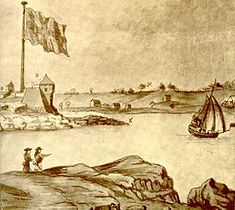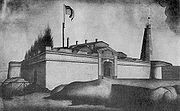
Fort William and Mary
Encyclopedia

New Castle, New Hampshire
New Castle is a town in Rockingham County, New Hampshire, United States. The population was 968 at the 2010 census. It is the smallest town in New Hampshire, and the only one located entirely on islands. It is home to Fort Constitution Historic Site, Fort Stark Historic Site, and the New Castle...
, New Hampshire
New Hampshire
New Hampshire is a state in the New England region of the northeastern United States of America. The state was named after the southern English county of Hampshire. It is bordered by Massachusetts to the south, Vermont to the west, Maine and the Atlantic Ocean to the east, and the Canadian...
at the mouth of the Piscataqua River
Piscataqua River
The Piscataqua River, in the northeastern United States, is a long tidal estuary formed by the confluence of the Salmon Falls and Cocheco rivers...
estuary
Estuary
An estuary is a partly enclosed coastal body of water with one or more rivers or streams flowing into it, and with a free connection to the open sea....
. First fortified by the British in 1632, the fort guarded access to the harbor at Portsmouth
Portsmouth, New Hampshire
Portsmouth is a city in Rockingham County, New Hampshire in the United States. It is the largest city but only the fourth-largest community in the county, with a population of 21,233 at the 2010 census...
.
On December 14, 1774, local Patriots from the Portsmouth area, led by John Langdon
John Langdon
John Langdon was a politician from Portsmouth, New Hampshire, and one of the first two United States senators from that state. Langdon was an early supporter of the Revolutionary War and later served in the Continental Congress...
, stormed the post and seized the garrison's powder, which was distributed through several New Hampshire towns for the use of local militias.
1774 raid

American Revolutionary War
The American Revolutionary War , the American War of Independence, or simply the Revolutionary War, began as a war between the Kingdom of Great Britain and thirteen British colonies in North America, and ended in a global war between several European great powers.The war was the result of the...
, Lord North's
Frederick North, Lord North
Frederick North, 2nd Earl of Guilford, KG, PC , more often known by his courtesy title, Lord North, which he used from 1752 until 1790, was Prime Minister of Great Britain from 1770 to 1782. He led Great Britain through most of the American War of Independence...
ministry had cautioned the colonial governors to secure arms, powder, and shot. Accordingly, in the summer of 1774 Governor John Wentworth
John Wentworth (governor)
Sir John Wentworth, 1st Baronet was the British colonial governor of New Hampshire at the time of the American Revolution. He was later also Lieutenant-Governor of Nova Scotia.-Early life:...
installed a small garrison to guard the fort's supplies. On October 19, King George III issued a confidential order forbidding the export of arms and powder to America. Nevertheless, word reached the locals.
The port at Boston had been closed since the Boston Tea Party
Boston Tea Party
The Boston Tea Party was a direct action by colonists in Boston, a town in the British colony of Massachusetts, against the British government and the monopolistic East India Company that controlled all the tea imported into the colonies...
and the city occupied. The Portsmouth Committees of Safety and Correspondence was aware that powder and shot had recently been seized elsewhere, including in Massachusetts (see Powder Alarm
Powder Alarm
The Powder Alarm was a massive popular reaction to the removal of gunpowder from a magazine by British soldiers under orders from General Thomas Gage, royal governor of the Province of Massachusetts Bay, on September 1, 1774...
) and Rhode Island
Rhode Island
The state of Rhode Island and Providence Plantations, more commonly referred to as Rhode Island , is a state in the New England region of the United States. It is the smallest U.S. state by area...
. Rumors flew reinforcements from Boston were expected. On December 13, Paul Revere
Paul Revere
Paul Revere was an American silversmith and a patriot in the American Revolution. He is most famous for alerting Colonial militia of approaching British forces before the battles of Lexington and Concord, as dramatized in Henry Wadsworth Longfellow's poem, Paul Revere's Ride...
sounded the alarm.
The next day, John Langdon made his way through Portsmouth with a drummer, collecting a crowd. About forty men responded to his challenge, setting upon the fort from the sea. A single volley rang from the British, answered by the Colonials, who quickly overwhelmed British Captain Cochran and his garrison of five men without injury. Breaking into the magazine, they removed seventy-two barrels of powder.
One day later, additional rebel forces came from throughout the colony. Led by John Sullivan
John Sullivan
John Sullivan was the third son of Irish immigrants, a United States general in the Revolutionary War, a delegate in the Continental Congress and a United States federal judge....
, they surrounded the governor's home, who averted violence by giving in to their demands. That evening, the rebels returned to the fort, removing all of the arms, supplies, and some cannons.
Aftermath
Despite his assurances to the contrary, Governor Wentworth had sent to Boston for help. The forty gun frigateFrigate
A frigate is any of several types of warship, the term having been used for ships of various sizes and roles over the last few centuries.In the 17th century, the term was used for any warship built for speed and maneuverability, the description often used being "frigate-built"...
Scarborough arrived on December 19 with one hundred marines. In spite of this, the governor and his family had to take refuge in the fort by the summer of 1775. Finally giving up, the British abandoned the fort and removed any remaining equipment to Boston along with Governor Wentworth.
The captured supplies were later used by New Hampshire
New Hampshire
New Hampshire is a state in the New England region of the northeastern United States of America. The state was named after the southern English county of Hampshire. It is bordered by Massachusetts to the south, Vermont to the west, Maine and the Atlantic Ocean to the east, and the Canadian...
's forces in the Siege of Boston
Siege of Boston
The Siege of Boston was the opening phase of the American Revolutionary War, in which New England militiamen—who later became part of the Continental Army—surrounded the town of Boston, Massachusetts, to prevent movement by the British Army garrisoned within...
.
Fort Constitution

Portsmouth Naval Shipyard
The Portsmouth Naval Shipyard , often called the Portsmouth Navy Yard, is a United States Navy shipyard located in Kittery on the southern boundary of Maine near the city of Portsmouth, New Hampshire. It is used for remodeling and repairing the Navy's ships...
was established upriver on Fernald's Island (now part of Seavey's Island) and the fort was rebuilt. Walls were doubled in height and new brick buildings added. Work was completed in 1808 and the defense renamed Fort Constitution. On July 4, 1809, an accidental explosion marred Independence Day
Independence Day (United States)
Independence Day, commonly known as the Fourth of July, is a federal holiday in the United States commemorating the adoption of the Declaration of Independence on July 4, 1776, declaring independence from the Kingdom of Great Britain...
celebrations at the fort, killing a number of soldiers and civilians. During the War of 1812
War of 1812
The War of 1812 was a military conflict fought between the forces of the United States of America and those of the British Empire. The Americans declared war in 1812 for several reasons, including trade restrictions because of Britain's ongoing war with France, impressment of American merchant...
the fort was manned and expanded, Walbach Tower, a Martello tower
Martello tower
Martello towers are small defensive forts built in several countries of the British Empire during the 19th century, from the time of the Napoleonic Wars onwards....
, being built in 1814.
During the Civil War
American Civil War
The American Civil War was a civil war fought in the United States of America. In response to the election of Abraham Lincoln as President of the United States, 11 southern slave states declared their secession from the United States and formed the Confederate States of America ; the other 25...
, Fort Constitution was rebuilt as a three-tiered granite
Granite
Granite is a common and widely occurring type of intrusive, felsic, igneous rock. Granite usually has a medium- to coarse-grained texture. Occasionally some individual crystals are larger than the groundmass, in which case the texture is known as porphyritic. A granitic rock with a porphyritic...
fortress. However, advances in weaponry, particularly armored, steam-powered warships with heavy guns, rendered the masonry design obsolete before it was finished. In 1897, construction began on Battery Farnsworth, located under the hill on which Walbach Tower stands. Named for Brigadier General Elon J. Farnsworth
Elon J. Farnsworth
Elon John Farnsworth was a Union Army cavalry general in the American Civil War, killed at the Battle of Gettysburg.-Early life and career:...
, the installation included two 8-inch breech-loading rifles on disappearing carriages. Given back to the state in 1961, Fort Constitution State Park was listed on the National Register of Historic Places
National Register of Historic Places
The National Register of Historic Places is the United States government's official list of districts, sites, buildings, structures, and objects deemed worthy of preservation...
in 1973, and is today open to the public.
The Lighthouse
Since 1771 the fort has been home to a lighthouse. The current installation, the Portsmouth Harbor LightPortsmouth Harbor Light
Portsmouth Harbor Lighthouse is located within Fort Constitution in New Castle, New Hampshire, USA.The station was established in 1771 and was the 10th of 11 light stations established prior to the American Revolution. The first tower was a shingled wooden structure with an iron lantern and copper...
, was completed in 1878. Its Fourth Order Fresnel lens
Fresnel lens
A Fresnel lens is a type of lens originally developed by French physicist Augustin-Jean Fresnel for lighthouses.The design allows the construction of lenses of large aperture and short focal length without the mass and volume of material that would be required by a lens of conventional design...
remains a valuable aid to navigation. The tower and the grounds immediately around it are open for scheduled tours.
Further reading
- Elwin L. Page. "The King's Powder, 1774," New England Quarterly Vol. 18, No. 1 (Mar., 1945), pp. 83-92 in JSTOR

